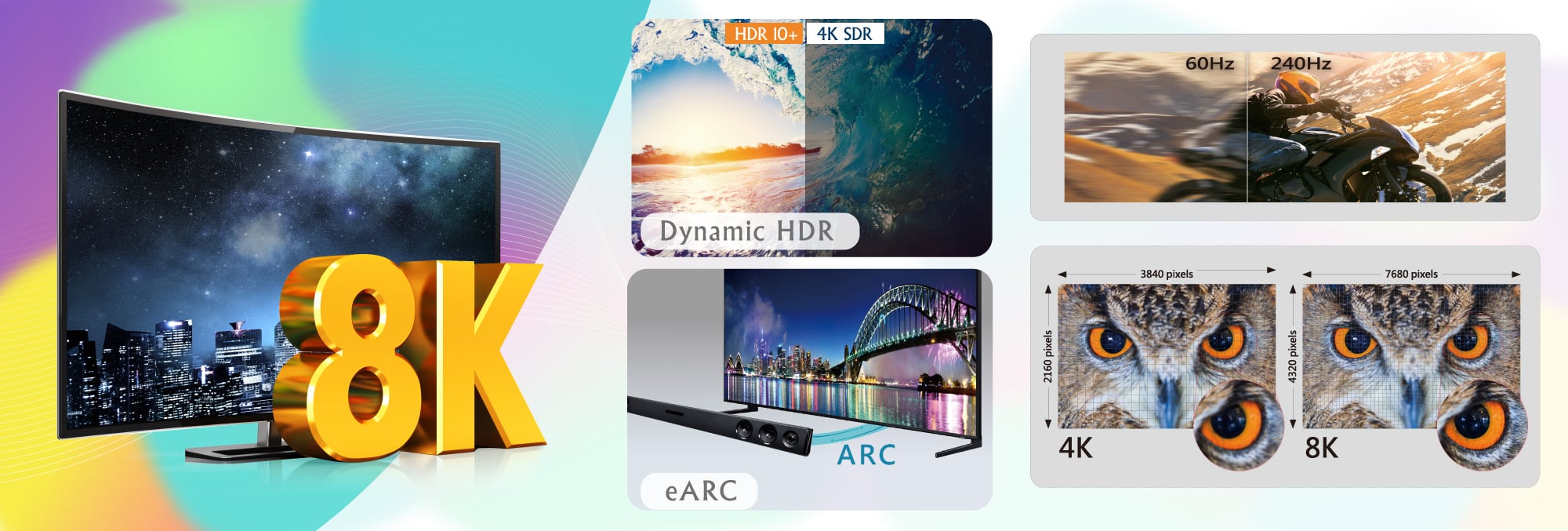What is HDMI 2.1? HDMI 2.1 Specifications & Technology Guide


Table of Contents
What Is HDMI 2.1?
The world of home entertainment has evolved significantly in recent years, and there’s no doubt that HDMI (High-Definition Multimedia Interface) technology has played an important role in this evolution.
HDMI 2.1 is the latest version of HDMI standard. It was introduced in 2017 and comes with several improvements over previous version HDMI 2.0. With HDMI 2.1, users can enjoy higher resolutions, higher refresh rates, and better HDR capabilities that are perfect for modern home theaters.
While it’s still a new technology, the benefits it brings to home entertainment are already becoming apparent, particularly for those who enjoy gaming or watching movies in the best possible picture and sound quality. HDMI 2.1 is truly the future of home entertainment connectivity.
Technical Specifications for HDMI 2.1
- Supports resolution up to 8K & 10K
- The most significant enhancement with HDMI 2.1 is its ability to support higher resolutions and refresh rates. HDMI 2.1 supports resolutions 8K60Hz and up to 10K, which is truly impressive. But perhaps more realistically, it can handle 4K resolution video at up to 120 frames per second, which is double what HDMI 2.0 can do. This means smoother and more lifelike motion in your movies and games, especially for fast-paced action.
- Supports HDR formats such as HDR10, Dolby Vision
- HDMI 2.1 also introduces a new HDR format called Dynamic HDR. It allows scene-by-scene or even frame-by-frame color and brightness enhancement, resulting in a significant improvement in perceived image quality. With this feature, you can enjoy brighter, more vibrant colors and highlights that are more realistic and dynamic than ever before.
- Offers improved refresh rates for smoother and lower latency gaming
- Another new feature of HDMI 2.1 is Variable Refresh Rate (VRR), which eliminates screen tearing and stuttering in gameplay by synchronizing the TV’s refresh rate with the frame rate of the source device. This feature is particularly interesting for gamers, as it ensures smooth gameplay even when the frame rate fluctuates. VRR is especially useful when gaming on consoles that can’t maintain a stable frame rate.
- Includes enhanced Audio Return Channel (eARC) for high-quality audio formats such as Dolby Atmos and DTS:X
- HDMI 2.1 also includes a new Audio Return Channel (eARC), which allows you to enjoy high-fidelity audio from your TV’s built-in streaming apps or any other source connected to the TV. With eARC, you can send uncompressed or lossless audio formats, such as Dolby Atmos and DTS:X, to your sound system via one HDMI cable.
- Offers higher bandwidth up to 48Gbps, allowing for uncompressed 8K video with HDR
- HDMI 2.1 offers the higher bandwidth capability enabling the transmission of uncompressed 8K video with HDR, providing an immersive and stunningly lifelike viewing experience that will revolutionize the way we watch movies, sports, and play games.
Benefits of HDMI 2.1
One of the biggest benefits of HDMI 2.1 is its ability to support higher resolutions and refresh rates. With HDMI 2.1, you can enjoy ultra-high-definition video at up to 120Hz, which provides a smoother and more enjoyable viewing experience. Additionally, HDMI 2.1 offers support for HDR formats such as HDR10 and Dolby Vision, which provide a wider range of colors and greater contrast in your video content.
Another key feature of HDMI 2.1 is its support for variable refresh rate (VRR). VRR eliminates the problem of screen tearing and stuttering that can occur in fast-paced video games. With VRR, your gaming experience will be smoother and more immersive, making HDMI 2.1 a must-have for serious gamers.
Is HDMI 2.1 Worth the Upgrade?
If you have a modern home theater setup or are a serious gamer, then HDMI 2.1 is definitely worth the upgrade. With its advanced features and improved capabilities, HDMI 2.1 can take your viewing and gaming experiences to the next level.
However, if you have an older setup and are not interested in upgrading your equipment, then you may not see a significant benefit from HDMI 2.1. In this case, you can stick with HDMI 2.0 or earlier versions of the HDMI standard and still enjoy high-quality video and audio content.
Trans relevant HDMI 2.1 Product: HD2-210X
